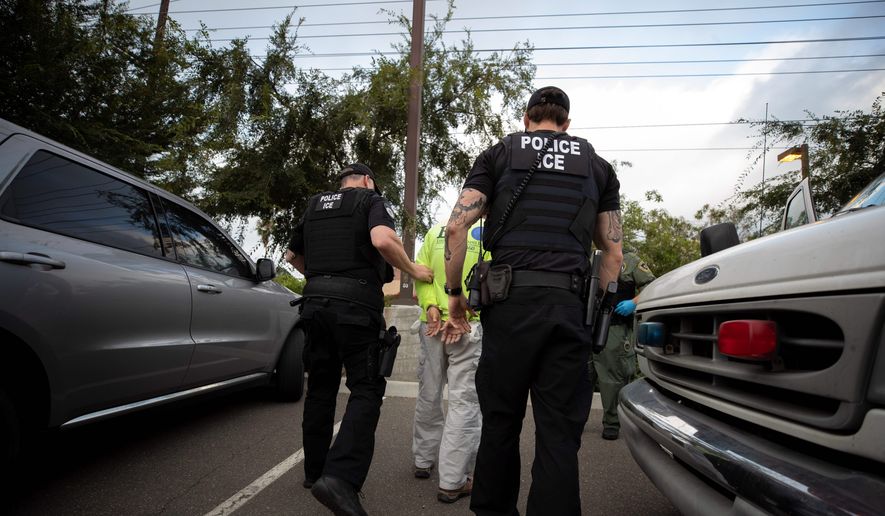Illegal immigration across the southwestern border is down so much that Homeland Security is now deporting more people each month than it captures coming across, officials announced Thursday, saying they’re now able to eat into the backlog of cases that built up during last year’s surge.
Acting Customs and Border Protection Commissioner Mark Morgan said illegal crossings did tick up slightly in February compared to January’s numbers, but it’s still far lower than the heights of last year’s wave.
The problem has shifted. No longer are Central American families bedeviling border officials, but smugglers are now looking both closer and father afield, turning back to single adult Mexicans and to Brazilian families, Mr. Morgan said.
But he said they’re in better shape to deal with the new situation, thanks to the policies put in place and the deals struck with Mexico and Central American countries over the last year, which give the government the chance to do something beyond just releasing illegal immigrants into American communities.
“We’ve got the tools in place now where we have the capacity to remove more people than we’re actually apprehending,” Mr. Morgan told reporters ahead of announcing the February numbers Thursday.
After eight months of declines, the number of illegal immigrants either apprehended by Border Patrol agents or encountered by officers at ports of entry ticked up from about 36,650 in January to about 37,100 in February.
In February 2019, by contrast about 76,550 unauthorized migrants were caught trying to enter.
And at the height of last year’s surge in May, more than 144,000 migrants were nabbed. Of those, more than 80,000 were immediately released into communities, because under a patchwork of laws and court rulings there was no way to hold and quickly deport them.
Most remain in the U.S. still, authorities believe.
But the new lower numbers at the border mean Homeland Security is finally cutting into the backlog, Mr. Morgan said.
“For the last five months, the number of those we removed have outpaced the number we have encountered at the southwest border,” he said.
In January, for example, Homeland Security ousted nearly 42,000 illegal immigrants, or about 5,200 more than were nabbed at the border.
Mr. Morgan said President Trump deserves credit for pushing the changes that allowed the U.S. government to get a handle on things. The administration suspended aid payments to key Central American countries until they agreed to do more to keep their people at home, and to try to stop other nationalities from using their territory as a crossing point.
And Mr. Trump personally threatened to slap tariffs on Mexico, which brought Mexican officials running to Washington to cut a deal. They agreed to expand their own immigration enforcement efforts, and agreed to accommodate people from Central America who crossed Mexican territory en route to the U.S., whom the U.S. then pushed back across the border to wait for their immigration court dates.
That U.S. policy, officially known as the Migrant Protection Protocol but more commonly called “Remain in Mexico,” has been a critical part of cutting the flow of Central Americans.
Mr. Morgan said the drop in numbers has taken hundreds of millions of dollars of profits out of the pocket of the smuggling cartels, who charge anywhere from $3,000 to more than $15,000 to smuggle a Central American into the U.S.
Looking for new customers, the cartels are now targeting others. Ecuador has become a hot new source for illegal immigrants. And the cartels are once again trying to recruit single adults from Mexico, officials say.
Brazil had been a major source late last year, but the U.S. government expanded its MPP deal with Mexico to allow Brazilians to be pushed back across the border, and the numbers immediately began to fall, plummeting from more than 1,600 in November to just 682 in February, according to Homeland Security data.
What most concerned Mr. Morgan was a spike in drug seizures.
He said fentanyl seizures were up 75% from January to February, cocaine was up 41%, heroin was up 11% and methamphetamine was up 30%.
Like migration, where a rise in the level of arrests is believed to mean a rise in the number of people successfully sneaking in, a rise in seizures is believed to signal a rise in the amount of drugs getting through.
He said that while the largest amount flows through the ports of entry in vehicles or strapped to travelers’ bodies, they’re seeing increasing seizures by Border Patrol agents between the ports.
Mr. Morgan said that’s another argument for finishing the border wall. He said that can funnel activity, forcing it to the ports, where each vehicle can be screened and he said they have good detection capabilities. Or, he said, it can force them to try to defeat the wall with drug tunnels.
“We want to drive them to take extreme measures to force them to spend a lot of time, effort and money to come up with new ways,” he said. “We want to make it hard for them.”
He pointed to the discovery of a second drug tunnel along the border this year as evidence that it’s working.
“The smugglers are getting desperate,” he said.
• Stephen Dinan can be reached at sdinan@washingtontimes.com.




Please read our comment policy before commenting.